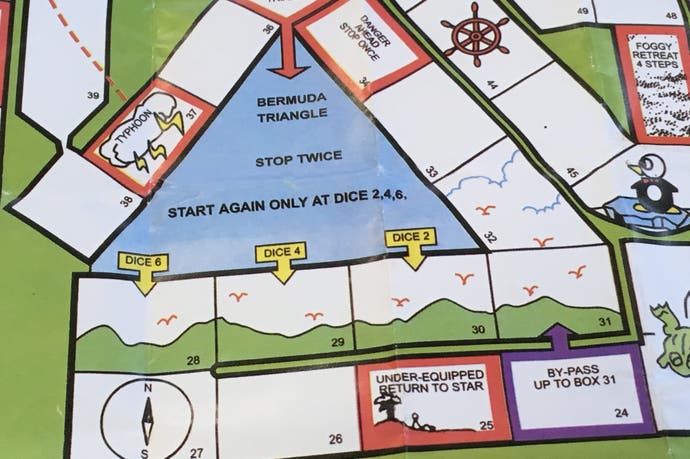An attempt to analyse a board game we just got in a Christmas cracker
FOGGY RETREAT 4 STEPS.
It was Eurogamer's Christmas Party at the end of last week, and that means that there were Christmas crackers knocking about and we were all showered with magnificent Christmas cracker gifts. Miniature picture frames, miniature screwdriver sets, miniature pens and pencils: by the end of the evening we had pretty much everything we would need to survive a ten-stretch in Mouse Prison. More importantly, though, Jamie Wallace got a miniature board game, which I made him hand over to me in the interests of science. It is called Voyage Game, and it is a document that I believe we will be studying for many years to come.
This is Voyage Game:

Please note, Voyage Game also came with three player pieces and a dice. (A die?) Let HANSARD record that the player pieces were a small red sailboat, a small blue ocean liner and a small yellow aircraft without wings. Do not tell Jamie, but in the interests of science I took these player pieces home and my cats lost two of them. The small blue ocean liner and the yellow aircraft without wings are now missing in action, possibly consumed, in which case you can add Terrible Cat Owner to my rap sheet next to Terrible Friend of Jamie Wallace.
No matter! We have the small red sailboat - who suddenly seems like a shoo-in for a top spot on the leaderboards - and we have the dice. Or die? I can never remember. More importantly we have the board - and frankly, I have noticed some things.
I noticed them because last night I tried to play a quick round of Voyage Game only to discover that there is no such thing as a quick round of Voyage Game, as Voyage Game itself is filled with enigmatic elements that make discussing them at length a crucial part of the fun. Let's discuss them now! (I am not promising actual fun, BTW.) First up for interpretation: just look at the first three squares.
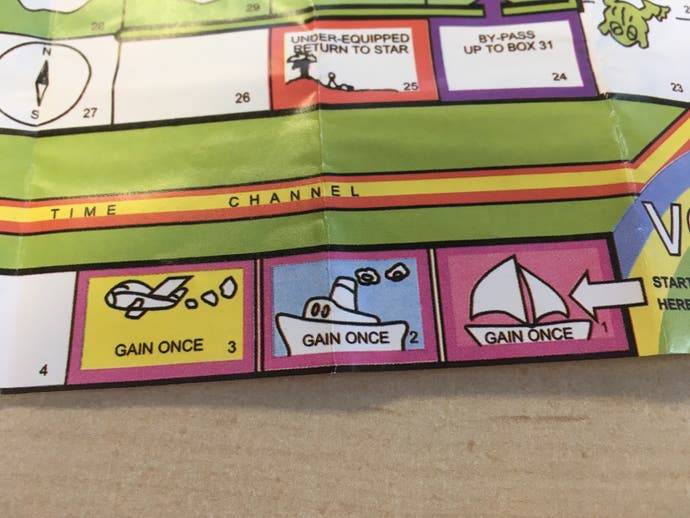
This is very confusing, isn't it? Is the game suggesting that each piece has its own starting point? If this is the case, the small yellow aircraft without wings - pictured here with wings magically intact - would be terribly OP, if it weren't for the fact that the cat has probably eaten it. Equally, the small red sailboat would be at a significant disadvantage. Luckily, karma - cat-ma? - has done a little rebalancing of the odds, and now we are left only to puzzle over the meaning of the phrase "GAIN ONCE". Gain what? From who? (Whom?) And why only once? Sheesh, this is going to be some voyage!

Okay, what's next? What's next is that square four is blank, square five has a waterfall - more on this one later! - square six has a cheeky whale and square seven has a message: SHORT-CUT FORWARD 8 STEPS. There is also a picture of a globe on square seven, at least I think that's what it is. I am also unsure how the weightings are deployed in that sentence. Is SHORT-CUT being used as a verb? Is there punctuation missing between SHORT-CUT and FORWARD? Why is the globe beset by strange winds?
The strangest thing here, though, is what we are learning about the structure of Voyage Game. Since Voyage Game ships, rather daringly, without instructions, its exact nature and ruleset must be uncovered through play. Imagine, if it is helpful, that you open a cracker at a Christmas party and Dark Souls falls out. You are in Lordran. GAIN ONCE. Luckily, Voyage Game can rely on the fact that by the point in a person's life at which they are cleared to wield the small explosive charge contained in a Christmas cracker, they have generally played other games. One look at the board and it's clear that Voyage Game is a chase game, a species of board game that goes back to the neolithic. Confusingly, though, how should we interpret the squares? The squares with instructions are easy enough to understand. Do what they say, even when they are employing SHORT-CUT in its rare verb form. The squares without images are pretty easy to understand, too. You just hang out there, I guess, until you get your next dice roll, or someone manufactures a distraction so everyone can escape and go home. But the squares with the images and no instructions? These are what my grandfather would have called a head-scratcher. The whale? No idea. Later on there is a red circle with a smiling face, a pair of binoculars, a frog - hopping from square 22 to square 23! - a compass, a ship's wheel and something that sort of looks like a penguin wearing Evel Knievel's crash helmet. I hope it's clear what I'm worrying about here. I'm worrying that these images have meaning beyond mere - excellent! - decoration, and that there is, in essence, a whole layer of ludic resonance to Voyage Game that I am missing out on. While my wife and I slowly chase each other around the board, me using the little red sailboat, my wife using her finger because, in the interests of a fair appraisal, I should be the one who gets the boat, maybe others are unpacking a game of unparalleled richness and depth. If I close my eyes, I can maybe hear them: "Oh man, I was streaming ahead, but then I landed on the hopping frog, and we all know what that means!" "Curse that ship's wheel! I was paging through the rulebook for hours after passing it with a five-roll, and I still don't know if I uttered the correct disenchantment spell as required."
All of this is interesting - and it is! - because ancient board games like Senet often have a mixture of blank squares and squares with images on them, and, because the rules have not survived, these images and their interpretation are the kind of things that careers are built upon. What I am saying is that Voyage Game has a fabulous lineage in the pantheon of board games, and that I should probably get an honorary doctorate for my work on it.
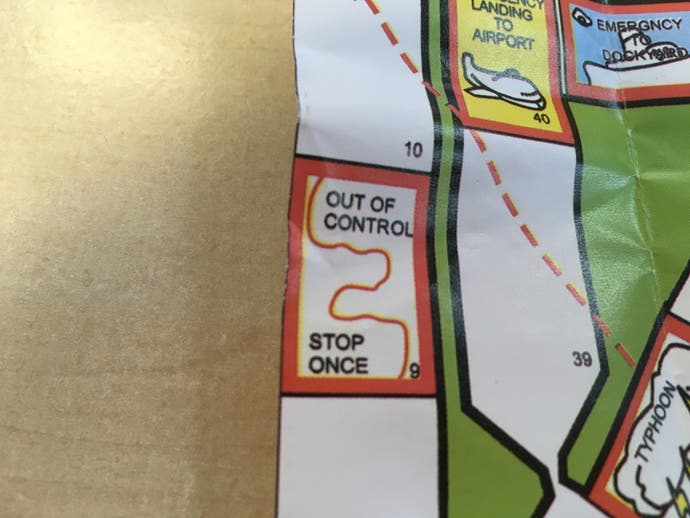
Screw this square.
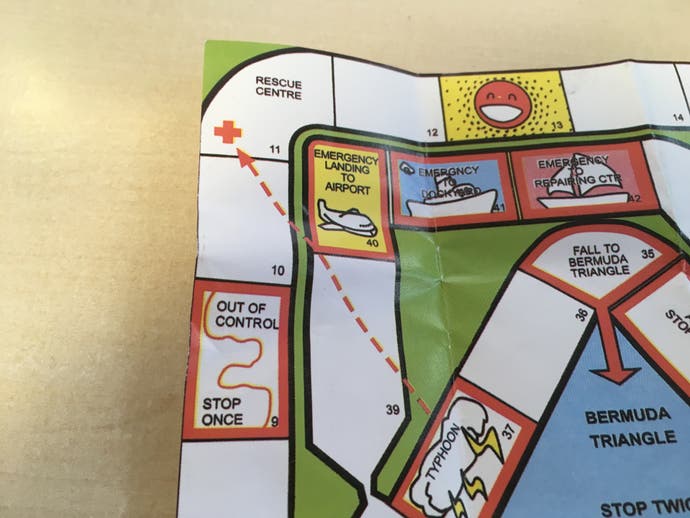
RESCUE CENTRE is important because the first time you pass it, it's no big deal. It's just square 11 with a stupid little cross on it. But when you eventually get to square 37, also known as TYPHOON, you realise that there is a whole world to RESCUE CENTRE that you had not considered, and it has just f*****d you up good and proper. Picture this. You are toodling along in your sailboat/ocean liner/aircraft without wings, and you encounter a typhoon, depicted, with curious meteorological elan, as a cloud with lightning emerging from it. Note the dotted red line that emerges from the TYPHOON square. It is a path, leading you back to the RESCUE CENTRE. Now listen, there are 50 squares in total in Voyage Game, so a drop from 37 to 11 is quite a bump. It is a bit like the time I was landing at Denver - long story - and our plane hit an air pocket and must have dropped 1000 feet. For years I told my friends that I'd been in a plane that had dropped 1000 feet and then my wife looked up air pockets the other day and said it was probably more like 10 feet, but she was still absolutely sure that I had been very brave about it regardless.
My point is this: TYPHOON is a jerk. And it's not alone. Square 21 sends you back to square five, the waterfall square, and its only justification is that you are LOST IN TIME. Square 35 announces "FALL TO BERMUDA TRIANGLE" and then you're stuck in some liminal blue zone at the centre of the board, thoroughly off the grid, until you roll the right number to get back to the game that has just treated you so badly. (Incidentally, you re-enter the game at an earlier square, so you can quite easily get stuck in a Bermuda Triangle loop. Just like my uncle Timmy, God protect him. This game is absolutely not screwing around, is it?)
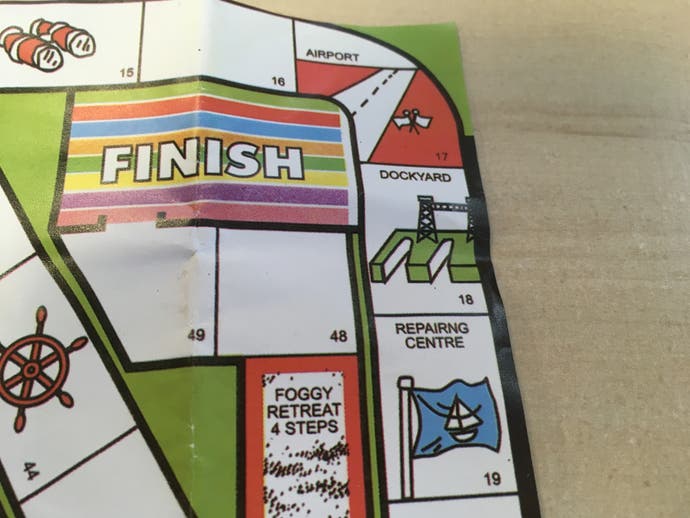
Squares 17, 18 and 19 have images on them - images that seem a little different to the majority of images on the board and invoke, in an uneasy way, the GAIN ONCE squares of 1, 2 and 3. These images are an airport, a dockyard and a repairing centre, and since the repairing centre has a sailboat on a flag, it seems like they're meant to correspond to your counter type. What do they do? If navigated successfully, will they provide some kind of protection against the LOST IN TIME square that is looming? Do they suggest a delay, in which you are restocked or fitted out? If so, why don't they just SAY that, the way that square 25 tells you you're under-equipped and you should "RETURN TO STAR"? (Only in typing this, and hunting around for a star which I cannot find, have I realised that this probably means "RETURN TO START", in which case square 25 can absolutely do one.) Oh, wait, later on there are squares that send you back to the airport, the dockyard or the repairing centre. But are they dependant on your choice of token in order to work their strange magic?
Conclusion
All of which is to say that I have enjoyed Voyage Game, I guess. I played for the best part of an evening, and after being under-equipped, after succumbing to being lost in time, I did eventually reach square 50, aka FINISH and a picture of a rainbow that has been straightened somehow. Yet the whole thing is confusing. It will not quite align itself as I want it to. I sense richness that is out of my grasp, and a coherency that seems to go beyond the basic theme of adventure.
It reminds me, in a way, of a joke I have been trying to make for the last year or so. They have built an apartment block outside my window in the Eurogamer office, and every evening, around five, grey smoke starts to pour from a little chimney on the roof of this apartment block. I am in the long-game mentality when it comes to joke-planning, and I have been toying with the idea of taking a picture of this smoke pouring from this chimney and then sticking it on Facebook with a caption suggesting that, once again, the apartments outside work have failed to elect a new pope. But I never do this, partly because I am not sure that people will get the reference, since they might not have read the Dan Brown book Angels and Demons, which hinges on the intricacy of papal handovers. And partly because I am not sure that the information about papal handovers that I read in Angels and Demons is in any way accurate.
Either way, this joke, while delightful to me, remains inchoate, and is, at best, what comedians might call a "ten-percenter." So much of the meaning is held in some kind of uncertain suspension, so much of the easy appeal may not be as easy or as appealing as it first seemed. A bit like, you know, a quick round of Voyage Game. Coming to a cracker near you soon, and bringing with it a lifetime of anxiety and distress.
